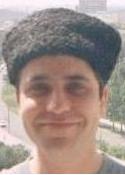
Faculty:Mechanical faculty
Speciality: Machines-Building Technology & production
In industry the wares of timbers are widely used with deformed tortsem: screw-bolts, screws, auto-nuts, screws, and etc. Production of these wares of high-automated, however for their making a separate technological equipment is used, that is ineffective, because requires large charges on maintenance of areas of productions, portage of details of a machine-tool to the machine-tool and other The simultaneous making of these wares on one technological line will allow to cut prime costs and promote the economical indexes of their making, avoid transport charges. Automation rotor line (ARL) is a mean of mass type of production, consequently the use of multi top-level lines of rotors will allow simultaneously to make small parties only technical details which are needed for making of only this series of wares. As a mean of the complex computer-aided manufacturing, the use of ARL will allow to automated weigh technological process of making of details with deformed edges, and the same to take time of their making to the minimum.
During carrying out researches were present scientific literature is analysis on the production of wares of timbers and lines of rotors. At research of the new spatial technological modules a computer design was widely used; at calculation of technical & economical indexes the methods of mathematical statistics were used. For development of complex technological process the theory of the graphs was used
Realization of principles of rotors and at creation of the new multi top-level systems of rotors will allow substantially to promote their flexibility, lifting restrictions, routing laid on a theory. It should be noted that except for the described new principles, for creation of the new high-effective multi top-level systems of rotors the known principles of planning from different industries of science and technique must be widely used. are theories of automation, technologies of engineer, tool-construction, etc. In addition, on crossing of new principles of planning and well-known creation of other principles, providing a receipt different from the examined properties is possible. Thus, the considered principles of planning allow to create new high multi top-level systems of rotors possessing .
Thus, the complex multi top-level computer-aided of details manufacturing with deformed edges requires the decision of certain higher tasks, namely: Decision of problem of re-equipment of automatic devices. Providing of saving of coefficient of the use of machines which are united in one line. Decision of problem of kinematics complication of machines. Providing of universality of technological machines, and their sufficient load: 1 Diminishing of amount of laws of motion of workings and transport organs. 2 Decision of problem of load and analysis details of different nomenclatures. 3 Standardization of external forms of details. 4 Providing of the necessary productivity of separate wares on condition of the different programs of issue of details.
1. Кошкин Л. Н. Роторные и роторно-конвейерные линии. - 2-е изд. стереотип. - М.:Машиностроение,1986. - 320 с., ил.
2. Кошкин Л. Н. Комплексная автоматизация производства на базе роторных линий., Изд. 2 - е, переработ. и доп. М., "Машиностроение", 1972, 351 стр.
3. Шаумян Г. А. Комплексная автоматизация производственных процессов. М., "Машиностроение", 1973, 640с.
4. Клусов И. А. Проектирование роторных машин и линий: Учеб. пособие для студентов машиностроит. спец. Вузов. - М.: Машиностроение, 1990. -320 с.
5. Роторные линии. И. А. Клусов И. А. Р. Сафарянц М., Машиностроение - 1969, 195 стр.
6. Остафьев В. А., Маслов В. П. Роторные и роторно - конвейерные линии в металлообработке. - К.: Тэхника, 1988. - 135с.
7. Автоматические роторные линии / И. А. Клусов, Н. В. Волков, В. И. Золотухин и др. - М.: Машиностроение, 1987. - 288с., ил.
8. Прейс В. В. Технологические роторные машины: вчера, сегодня, завтра. - М.: Машиностроение, 1986. - 128с., ил.
9. Васильев С. П. Производство крепежных изделий. Учебник для ПТУ. М., "Металлургия", 1981, 104с.
10. Петриков В. Г., Власов А. П. Прогрессивные крепежные изделия. - М.: Машиностроение, 1991.- 256с.: ил.
11. Биргер И. А., Иосилевич Г. Б. Резьбовые соединения. Библиотека конструктора. М., "Машиностроение", 1973, стр. 256.
12. Владимиров Ю. В., Герасимов В. Я. Технологические основы холодной высадки стержневых изделий. - М.: Машиностроение, 1984.
13. Мисожников В. М. Холодная высадка крепежных деталей: обзор. - М.: ЦИНТИМАШ, - 64с.
14. Якухин В. Г. Оптимальная технология изготовления резьб. - М.: Машиностроение, 1985 - 184с.
При проведении исследований широко использовались ресурсы